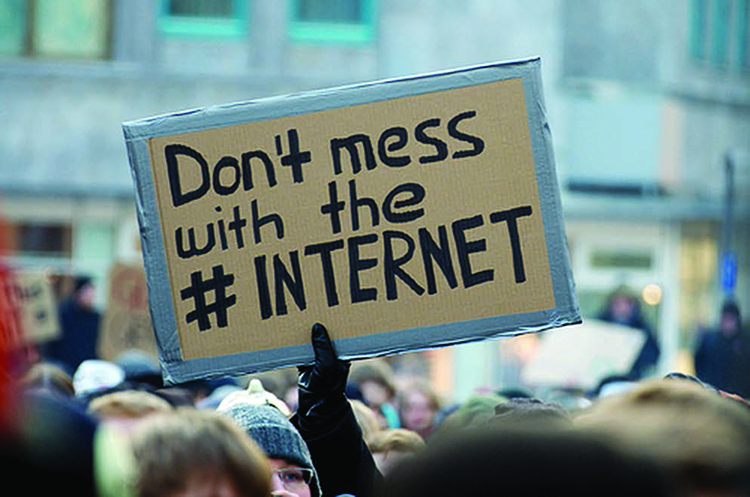Earlier this year, a feminist meme sprang up on the microblogging site Tumblr. Participants posted messages that began “I need feminism because ” and completed the thought with their personal takes on the issue. A heterosexual man declared he needed feminism because his friends mistook his habit of treating women decently as a ploy to pick up women… or a sign that he was gay. Someone said “I need feminism because we keep confusing objectification of women with liberation of women.” Others addressed workplace discrimination, restrictive gender roles, pervasive sexual violence and harassment, etc. It was hugely popular. A group of antifeminist “men’s rights activists” (MRAs) reacted by launching a syntactically parallel counter-campaign on Twitter. They replaced the word “feminism” with “masculism” in a newly created hashtag: #INeedMasculismBecause.
What unfolded, thanks to the immense viral force of hashtags, points to a new dialectic; a new approach to how people hash out – so to speak – their philosophical disputes.
A hashtag (for the uninitiated among us) is a string of text preceded by a pound sign (#) that operates as a label for packets of content on various social networking and microblogging platforms, most notably, Twitter. It’s a simple typographical convention that requires no specialized skill. Anyone posting on such sites can create hashtags and attach them to their messages. Hashtags are searchable and hyperlinked, so anyone interested in the topic described by a hashtag can find posts on that topic grouped together in a streamlined, easy to follow configuration, like a live, continually updating index. At least, that’s the theory.
Popular hashtags are highlighted in various ways. On Twitter, frequently used hashtags become “trending topics” and are displayed on every user’s profile page. This allows people to learn what others are talking about in their community and maybe even get a handle on some piece of the zeitgeist. Again, that’s the theory.
In practice, hashtags are used mostly as promotional copy. Trending topics let you increase and accelerate the visibility of whatever you’re promoting by getting others to tweet your hashtag. The search and link features serve as a sort of broadcast channel rolled right into the promotional text. This means hashtags are ideal vehicles for pushing commercial products and services, jokes, pranks, professional association events, cultural programmes, public service announcements, political campaigns, and ideological rallies.
If you have a nose for hot trends influencing your target demographic, you can even manipulate that to create an artificial buzz around your hashtag. When hashtags first came out, you could have easily sold candy to tweens by labeling your campaign “#JustinBieberCool.” You can probably still sell to the same kids, now in their teens, by switching to “#JustinBieberDork.” Each day, one promotional hashtag (usually for a commercial interest) outright buys the top spot on that day’s “trending topics” list (for up to $200,000), with no pretense that anyone is actually tweeting about it.
In effect, the primary function of hashtags is becoming less and less relevant as a tool for you to find content – aka an index – and more and more as a tool for content to find to you, aka spam.
What’s salient about this form of spam, however, is that the way it works is completely open, nonhierarchical, libertarian, and democratic. Anyone can produce it or adapt it to suit his/her own needs and people are doing so in very creative ways. They use hashtags to signal conformity (or nonconformity) to a group. Some use them to endorse (or disparage) certain ideologies. Others use them as personalized signatures and style statements, thereby turning the hashtag’s indexing function on its head by using it to distinguish rather than classify.
One of the most popular – and striking – uses of hashtags is to generate (and also to appropriate and destroy) cultural and ideological memes. This practice has brilliantly merged the hashtag’s de facto spamminess with its inherent semantic power to fashion a potent new weapon in dialectical wars.
In the feminist-versus-MRA example, the MRA hashtag #INeedMasculismBecause was meant to neutralize the earlier feminist meme by inciting a (presumably) vast brotherhood of oppressed men who would (presumably) come out in droves to put the “feminazis” in their place.
But a funny thing happened on the way to the counterrevolution. Men and women came out in droves to support feminists instead. They overwhelmed the MRA hashtag with ironic tweets about the absurdity of demanding retributive justice against the perceived “oppression” of men by feminism. “#INeedMasculismBecause the state, executive and judiciary just aren’t enough,” chirped one Tweeter. “#INeedMasculismBecause women aren’t going to harass themselves,” chimed in another.
Others gave more substantive responses. Some of the MRAs, apparently unaware of any actual feminist thought, had complained about the stereotyping of men, the presumption that all men are sexual aggressors or bad parents, and the expectation that men should keep their emotions in check and always pick up the dinner tab. One feminist addressed such issues in a lighthearted but thoughtful post of his own: “#INeedMasculismBecause gender essentialism & patriarchy legitimately hurt men too— huh? feminism already has that covered? Cool! Never mind.”
Within hours, the entire antifeminist programme fizzled out and masculism’s crowning achievement turned out to be the categorical rebuttal, once and for all, of the stereotype of the humour-impaired feminist.
Platforms like Twitter are not scholarly conferences, or even freethinkers’ salons. They are soapboxes in the public square. Occasionally, you might hear a well-considered argument and, with rare luck, maybe even a thoughtful and good-faith counterargument. But mostly it’s just people shouting their slogans, applauded by the likeminded, booed by the detractors, and generally ignored by most people who happen to be strolling by.
Yet, as subversive hashtag wars go, this was a rather unremarkable skirmish. Hashtags get sabotaged all the time. During the 2012 U.S. presidential election, the Mitt Romney campaign floated the hashtag “#FailingAgenda” and invited Romney supporters to use it to tweet about Barack Obama’s “failing agenda.” It backfired colossally when legions of Obama supporters gleefully coopted and inverted the meme by articulating Romney’s “failing agenda” under the hashtag’s banner. Sometimes the subversion is not even deliberate. In August, 2013, a social media watcher reported on Storify.com that the hashtag “#ImVotingLiberal” was “hijacked three times within twelve hours.” The hashtag was created one morning in Australia by right leaning “liberals” (in the classical economic sense) and later taken over by Australian progressives to rant sarcastically about liberalism. Hours later, as the Australian day waned, morning broke on the other side of the planet and American “liberals” (progressives and leftists) woke up to a new “trending topic” that was apparently close to their hearts. Not realizing that “liberal” has the opposite meaning in Australia, they heartily, and earnestly, tweeted about why they were voting “liberal.” Inevitably, American conservatives hijacked the thread again and tweeted sarcastically about progressive “liberalism” – apparently with no inkling of how closely aligned their own values were to the original “liberal” creators of the hashtag.
At first blush, “hijacking” a hashtag seems wrong. It denies the original “speaker” his/her argument’s premise. On the other hand, perhaps weaving an “argument” into a hashtag is itself an act of hijacking. It misappropriates the very purpose of hashtags. Hashtags are supposed to index an ongoing discourse. Like any topic label in an index, they should lead you to all the material available on the topic. But if the purported “topic label” is encoded with a particular perspective or presumes a particular conclusion, then it becomes pretty useless as a tool for accessing meaningful discourse. Perhaps “hijacking” the hashtag is one way to introduce a dissenting view into the conversation and rescue the forum from becoming an echo chamber.
In reality, it’s more likely that the whole thing devolves into a war of competing echo chambers. And the louder side “wins.” In the Twitter version of dialectical sparring, when we come to an impasse and find ourselves hamstrung by a 140-character limit, a cultural preference for pith over depth, and our own inability (or unwillingness) to do the work of persuading or being persuaded by the actual content, we simply weaponize the indexing system in order to win.
In the feminist-masculist example, my own sympathies happen to lie with the winning side. But I am compelled to recognize that, despite having superior reason on their side, the feminists didn’t win on the merits of their argument. They won by the strength of their numbers. And that hardly makes for meaningful discourse.
But then, isn’t this how democracy works? Twitter is essentially democratic, and that fact is the source of both its strength and its weakness. In democracy, everyone gets a voice, which is a key requirement for what I’ve been calling “meaningful discourse.” This makes it easy to assume that democratic systems naturally tend to foster such discourse. The counterintuitive truth is that they really don’t. Meaningful discourse can only happen when participants agree to uphold democracy and also agree to comply with an array of additional requirements, such as tolerance, intellectual honesty, discipline, patience, and openness to persuasion. Otherwise, when majority views emerge – because everyone has a “voice” with which to transmit their views – the combined voices of the majority form a de facto “human megaphone” (to borrow a term from Occupy Wall Street). All other individual voices – voices of dissent, or even the subtlest diverging nuance – are drowned out.
Democracy, by its very nature, then, encourages conformity and regression to the mean rather than robust debate and independent thought. However, what democracy also does, (better than any other non-anarchical power arrangement), is that it allows for independent thought and debate to find niches and flourish on their own. Democracy creates the conditions wherein people with minority views (or people interested in engaging divergent views) can move to a different part of the public square, where they can hear each other and hash out their arguments with each other, despite the megaphone in the background.
Platforms like Twitter are not scholarly conferences, or even freethinkers’ salons. They are soapboxes in the public square. Occasionally, you might hear a well-considered argument and, with rare luck, maybe even a thoughtful and good-faith counterargument. But mostly it’s just people shouting their slogans, applauded by the likeminded, booed by the detractors, and generally ignored by most people who happen to be strolling by. When large scale engagement does happen, they are in the form of rallies, demonstrations and protests. They will usually end with the human megaphone… sometimes two human megaphones blaring at each other.
Back in the early days of Twitter, there were some “open source” guys (the information age equivalent of “freethinkers”) who devised a brilliantly simple and democratic way to index the soapbox output. They picked an arbitrary symbol (#) and assigned it the job of labeling things in order to organize and make sense of what they shared and consumed in the vast chaos of Web 2.0.
But maybe something inherent in the nature of soapbox speeches just doesn’t allow for “indexing”. Maybe the chaos of the public square is destined to be dominated by sloganeers’ diatribes and hawkers’ calls…. And hashtags are destined to proliferate commercial spam, pornography, celebrity gossip, viral “humour”, and competing ideological megaphones. Maybe you can’t turn the agora into a symposium and you can’t turn Twitter into a philosophy message board.
Fortunately, you can always find or create a forum of your own on the democratic web. Even on Twitter, you can mark your own little corner with a sufficiently imaginative hashtag that will only be recognized by people who will uphold rigorous standards of good faith and spam-free conduct. It’s still a remarkably efficient way to have useful conversation, if you can pull it off.
Just don’t expect the entire Twitterverse to comply… and don’t expect to be the next trending topic.


